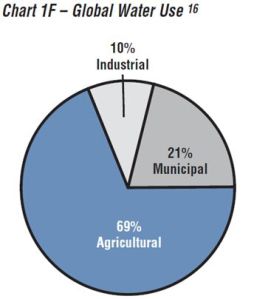Water Availability
To the casual observer, water seems to be the most abundant resource available on Earth. The reality is that 97% of all water is saltwater, 2% is held in snow and icebergs and only 1% is freshwater (the only portion currently useable for human consumption).
Earth’s freshwater is continually being recycled as it evaporates and returns to the Earth in the form of rain, snow and ice. Most of this “fallen” water evaporates immediately, pours into inaccessible areas, or flows into the oceans before it can be retrieved. Only about 10% of total rainfall on earth is retrievable for use by humans. And of that percentage, only 40% (or 4% of total rainfall) is ultimately used.

This chart represents the 3 major sectors of human water consumption.
From: The Intelligent Use of Water
(An Intelligent White Paper By: Anthony LaFetra, and available in 9 languages)
Rainwater Harvesting has a number of benefits and advantages as follows:
-
Rainwater is the only free natural commodity we have
-
All rain water usage benefits and advantages refer to rural as well as urban environments, both domestically and globally
-
Rainwater provides high water quality: it is already soft water (pH neutral or slightly acidic; excellent for showers, washing, etc), Rainwater has almost no minerals which causes damage to plumbing fixtures
-
Rainwater harvesting reduces surface runoff and flood flows of pollutants into storm sewers; to streams, rivers, lakes, and the oceans
-
Rainwater harvesting reduces erosion and sedimentation, that can suffocate marine life
-
Rainwater needs minimal treatment for potable use
-
Rainwater harvesting requires relatively low-cost designs
-
Rainwater harvesting reduces utility bills for consumers
-
Rainwater harvesting can delay or even eliminate expansion expenses of municipal water systems and private public water systems.
Leave a comment